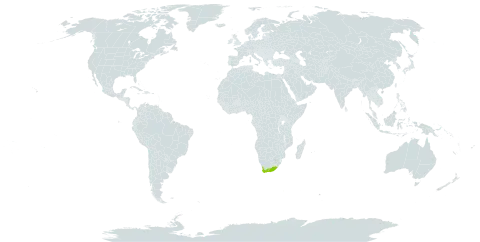Multi-stemmed, woody shrubs, up to 0.4 m tall. Branches very densely or sparsely villous. Leaves linear-lanceolate, up to 10 mm long, mostly flat but also varying from almost flat to involute on the same plant, straight or slightly twisted; adpressed below the inflorescence, spreading lower down; abaxial surface with dense or sparse, long, flexible, adpressed hairs; adaxial surface hairs often geniculate, curled or with a loose loop in the middle; apices subaristate. Synflorescences globular to cylindrical, with interspersed subtending leaves, individual clusters of capitula and subtending leaves often clustered on the axis or much denser, and individual clusters not distinguishable. Capitula homogamous, discoid, 1-flowered. Receptacle reduced. Involucral bracts 8-14, in few rows, outer about half the length of the inner, leafy, sparsely or densely tomentose; innermost brown, scarious, acuminate to mucronate with a long aristate tip, the longest as long as or a little longer than the corolla tube. Florets bisexual, white or pink, tube 4 mm long; corolla lobes narrow, spreading, 1 mm long. Stamens 5, apical appendage lanceolate, basally tailed. Style bifid, branches not exceeding the corolla lobes, swollen at the base. Nectaries present. Cypselas short hairy, hairs adpressed, slightly longer towards the annulus. Pappus setae 12-15, slightly joined at the base, shorter than the corolla tube, plumose from close to the base, plumes fine, soft, ascending.
More
Multi-stemmed shrub, up to 0.4 m high. Leaves linear-lanceolate, up to 10 mm long, lower surface with dense or sparse, long, flexible, appressed hairs, upper surface hairs often geniculate, curled or with a loose loop in middle, apex subaristate. Synflorescence globular to cylindrical; involucral bracts 8-14, in few rows, innermost brown, scarious, acuminate to mucronate with a long aristate tip. Florets white or pink, lobes spreading. Nectaries present. Flowering time Mar., Apr. Pappus of 12-15 setae, slightly joined at base. Cypselae short-hairy, hairs appressed.
Densely leafy, thinly white-woolly shrublet to 40 cm. Leaves linear with involute margins, often twisted, erect on peduncles but spreading elsewhere. Flower heads discoid, crowded in terminal glomerules, florets conspicuous, white; bracts brown.
